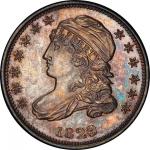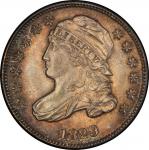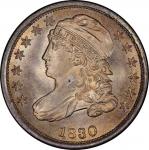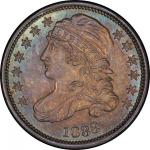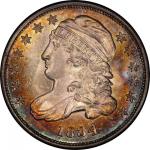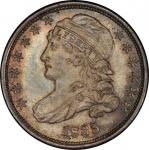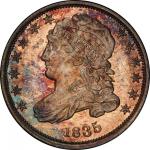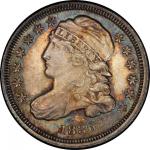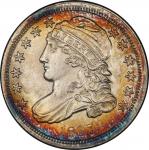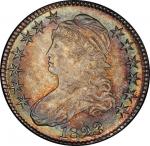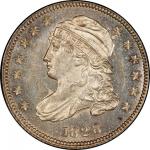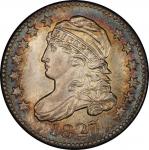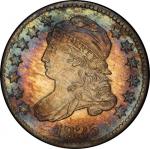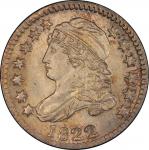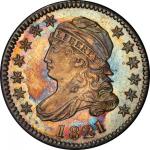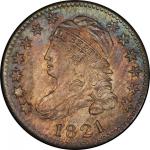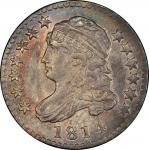“The best UNCs are from a tiny hoard released by one of Paul Revere’s descendants about 1956.” — Walter Breen, Walter Breen’s Complete Encyclopedia of United States and Colonial Coins, 1988. Rich with originality and bathed in opalescent gray toning, this is one of the finest extant dimes of this date. Subtle highlights of silver gray, olive, gold, and amber intermingle on both sides, with abundant frost that matches the superlative technical grade. Both sides are well struck and pristine, clearly left alone and well preserved for untold decades. An oval of toning above star 8 links this piece to its legendary provenance. Only the curl below B of LIBERTY lacks its full strike. Even the eagle’s talons are fully rendered. A series of interesting die cracks is visible on the obverse. One appears to begin at the highest relief of Liberty’s cap, crossing her eye and the bridge of her nose before arcing through the left obverse field to stars 3, 2, and 1. At star 1, another network begins, with a crack joining the outer point to the rim and reappearing at the northeast point, where it divides into a delicate crack that runs parallel to the bust and disappears in the field above it and a heavier crack that crosses the bust and connects the tops of 182. A vertical crack enters the base of 9 but leaves the top of that digit much thinner before intersecting the base of the lowest curl. On the reverse, a crack connects the beaded border to the left top of the first T in STATES. A nearly invisible crack runs along the bases of TED S, another joins the bases of F AME, and a short branch connects the right base of the first T in STATES to the top of the ribbon below. In his Complete Encyclopedia, Walter Breen reported a “tiny hoard” of this variety, which he attributes to “one of Paul Revere’s descendants.” With its nonchalant combination of vagueness and irrelevance, this reference encapsulates the sort of careless marriage of half truths and hopeful storytelling that has plagued even useful works of numismatic research for generations. Revere, who died 11 years before this coin was struck, had 16 children, of whom 11 survived to adulthood; in 1956, when Breen estimates this group came to light, Revere’s descendants numbered in the thousands. Breen’s teasing comment could refer to a single high grade specimen being sold to New Netherlands Coin Company during his employment there or to a sock full of gems being secretly dispersed onto the market one at a time. With just 11 submissions of 1829 Large 10C dimes resulting in Mint State grades at PCGS, less than half of which were assigned grades of MS-65 or finer, the former scenario is probably closer to the truth, if the statement contains any truth at all. This example, tied for finest known honors with one other example of the Large 10C type, likely entered the Eliasberg Collection with the acquisition of the Clapp Collection in 1942. Clapp’s inventory reflects the presence of three 1829 dimes called “Proof” and two called “Mint State,” which may align with the five 1829 dimes sold in the 1996 Eliasberg sale. Even with this decades-old provenance, another high grade example of this variety bears an even earlier provenance: the gem specimen sold in the January 1995 Bowers and Merena sale came from the family collection of Commodore Matthew C. Perry, whose last additions were made before Lyman Low was hired to appraise the family coins in 1898. The 1829 “Large 10C” variety, as designated by PCGS for most of its existence, appears to refer to JR-1 and JR-2, though a recently added designation for “Extra Large 10C” clearly aligns with 1829 JR-1 alone. Most high grade survivors of this PCGS variety appear to be from the JR-2 die marriage. The JR book notes that “six or more specimens exist in MS-60 or better condition,” but none have ever been found finer than this. Only four 1829 dimes of all varieties have ever received the MS-67 grade, the highest level attained by any specimen of this date. PCGS# 94511. NGC ID: 2378.

